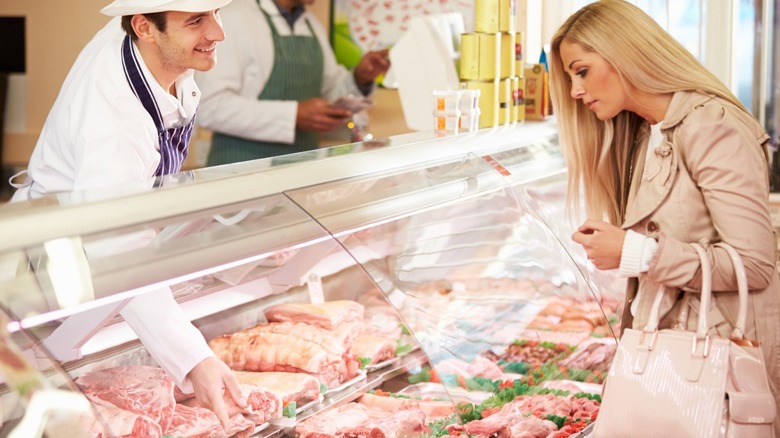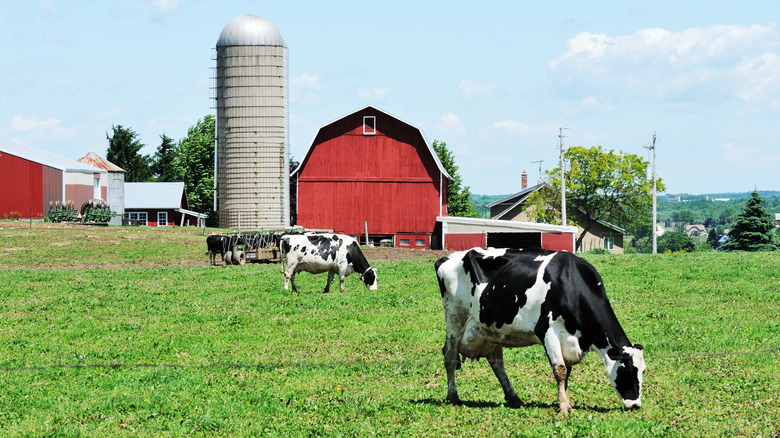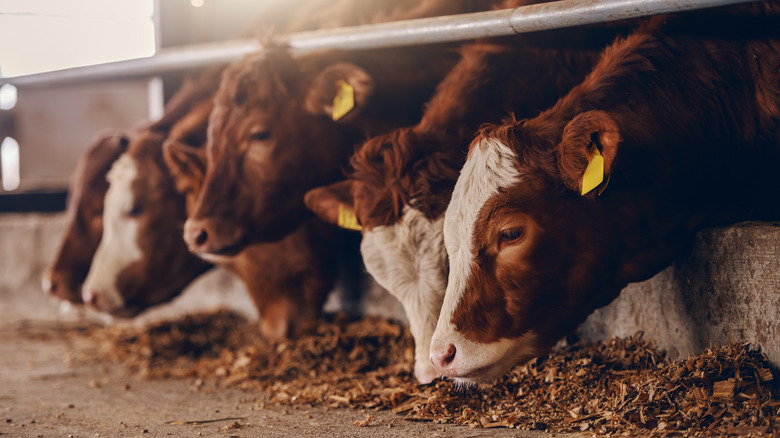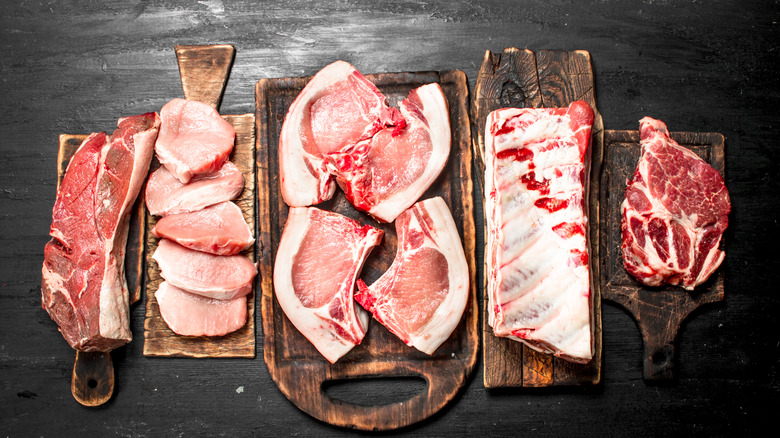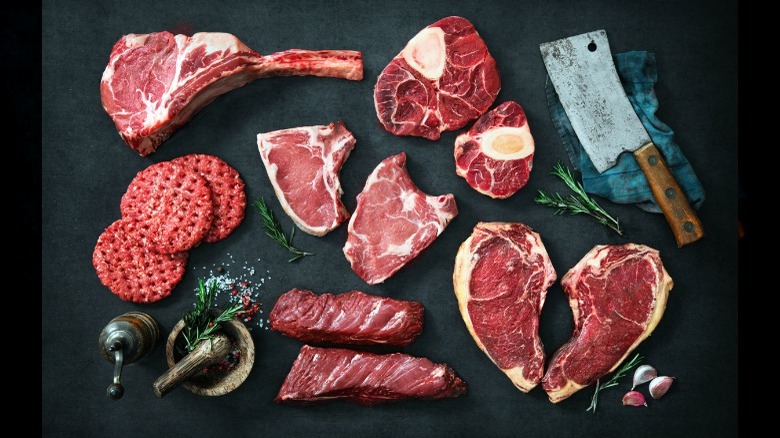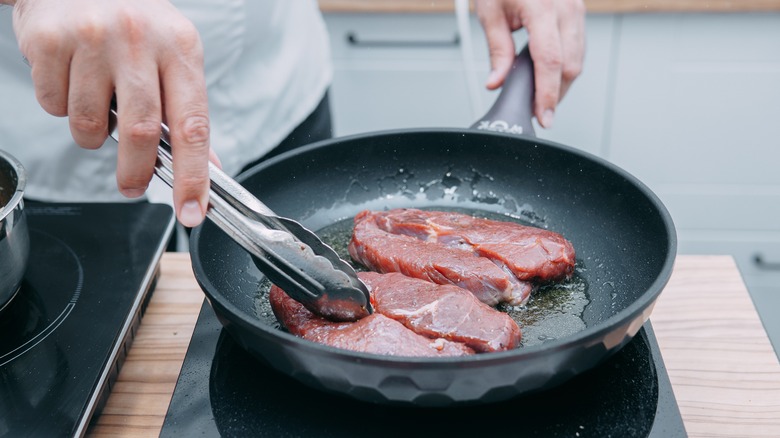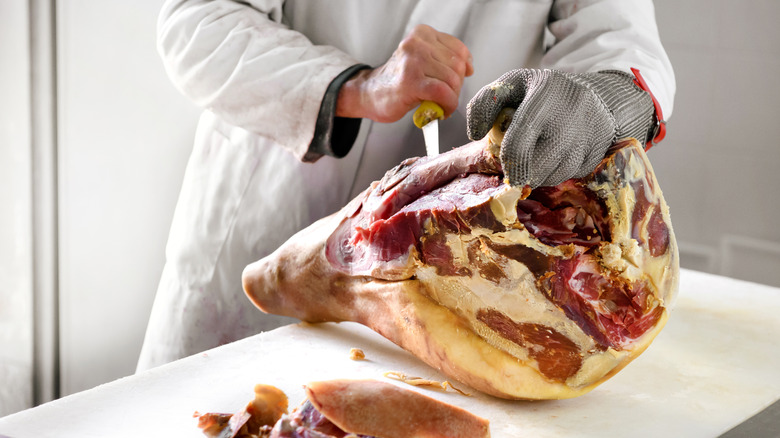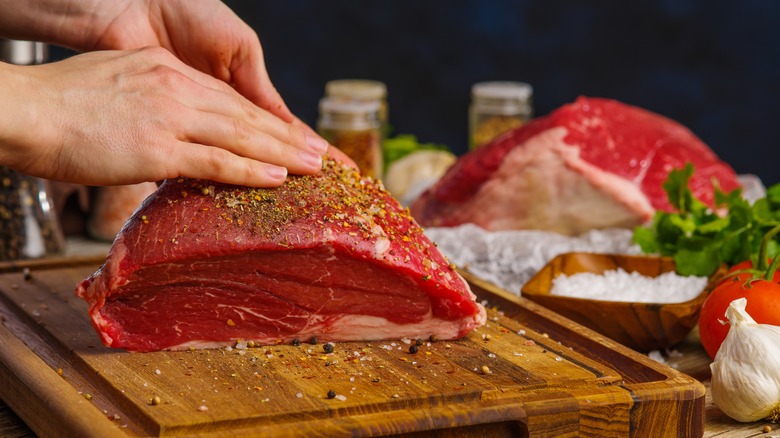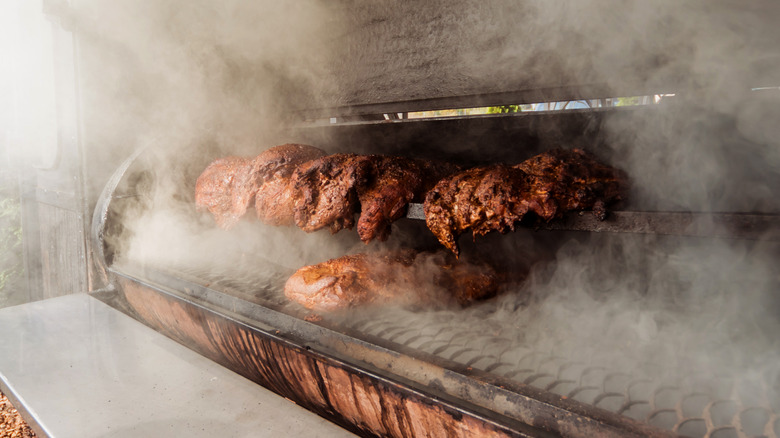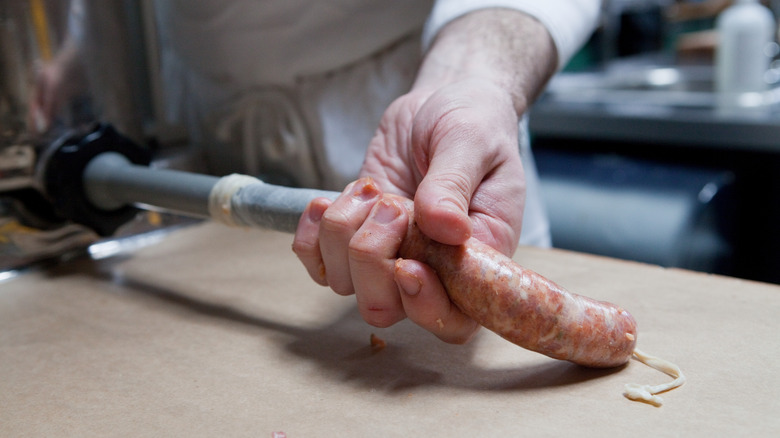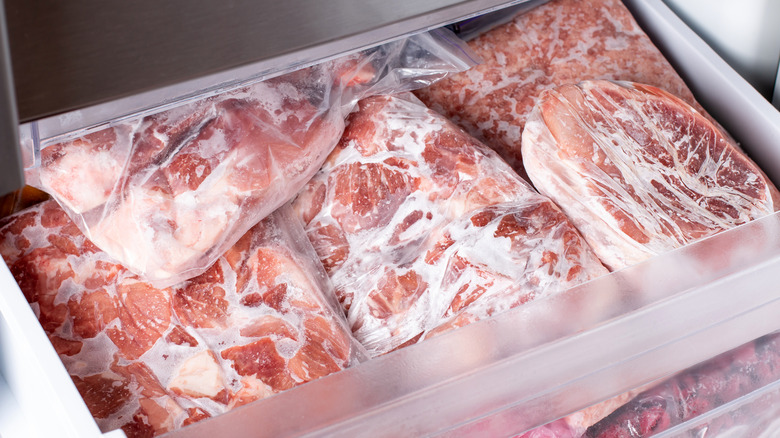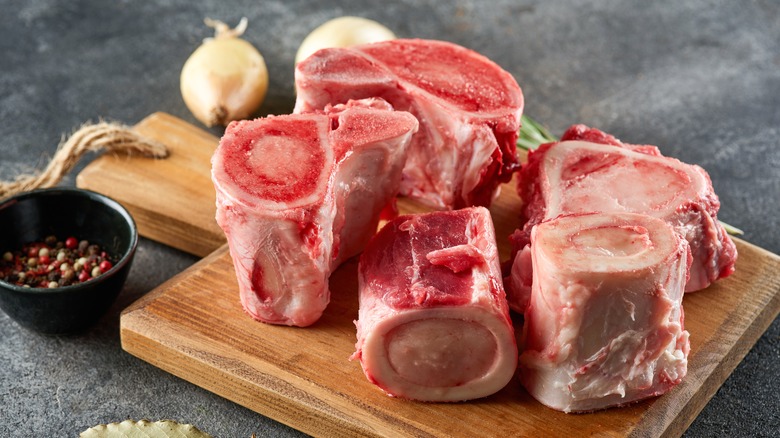12 Questions You Should Always Ask A Butcher
Have you ever walked into a butcher shop knowing exactly what you were going to make for dinner, but upon seeing all the beautiful cuts of meat were suddenly overwhelmed and unsure? You knew you wanted steak for dinner but they're having a special on hamburger. Or something's come up and that roast you were planning on braising for four or five hours is going to have to wait a couple days? What should you do? Well, the people behind that counter are there to help. It's their job to guide the shopper through the process so you not only make the right decision for the perfect meal but ensure that whatever you decide to make that evening or next week comes out perfectly.
In order to steer you through your next trip to the meat market, we asked a few butchers the most common questions they get every day, and which questions you should absolutely ask to guarantee that you leave with exactly what your next meal needs.
Where does the meat come from?
Several butchers said that the most common question they get isn't the preferred cut or how to cook the meat, but where the meat comes from. Is it local or is it traveling a great distance? While this may not seem like an important question, it is. Where your meat comes from directly affects the meat itself. The United States is the world's largest producer of beef and poultry with the majority of meat coming from JBS USA in Colorado and Tyson Foods Inc in Arkansas.
Because the meat has to be packaged and shipped all over the states, how quickly the meat is cut down and packaged directly relates to the condition of the meat. It takes about four days for pork to tenderize and beef about eight days, notes Massive Science. So, the longer the meat is stored, the more tender it will be.
But, because meat is in such high demand, Texas A&M reports that a lot of farms and meat processors are speeding up their shipping periods, which means using techniques such as physical force, electrical stimulation, or adding salts and enzymes to achieve a more tender piece of meat. These are all important things to consider when buying meat or poultry.
What do the animals eat?
Almost as important as where the animals come from is what they're eating. Do the animals roam freely, grazing on grassy knolls, or are they in pens fed a variety of hay, grains, and corn? A lot of butchers promote themselves as vendors of sustainable and humanely raised meats because they know that what an animal eats is just as important as how they're raised. Jered Standing, owner of Standing's butchery says that all his beef and lamb are grass-fed. For the other meat he sells, Standing explains a "species-appropriate diet" is key: "Chickens eat bugs and worms in addition to a grain feed. Pigs eat everything while rooting for roots and tubers and nuts."
But, what the animals are fed isn't just about if it's good for them or not. Turns out that what they eat directly relates to the meat's composition. Healthline says grass-fed beef tends to contain less fat and so will be a leaner piece of meat with more Omega-3 fats, Vitamin A and E. Grain-fed cows, on the other hand, tend to have more fat or marbling, according to North Carolina State University. Some believe that marbling leads to a tastier, more tender cut since the fat imbues the meat with flavor as it cooks.
Which cut would you recommend?
When you walk into the butcher shop, you stare into the clear case and see so many beautiful cuts of beef, chicken, pork, and maybe even lamb all laid out in lines ready to be turned into an amazing dinner, you could get dizzy. You may have walked in with a plan, but upon seeing all those choices were suddenly dumbfounded about what to make and which cut to use. Well, that's where the butcher will help.
Jered Standing of Standing's Butchery says a professional can let you know what's good to purchase that day, depending on factors such as availability or freshness. "This is a way better approach than coming in with something specific in mind already. ... Coming in with an open mind and maybe a preferred cooking method will make sure you always get the best thing," says Standing.
Picking the right piece of meat will make preparing a meal that much easier. And with so many different cuts of steak, it's easy to get confused about which is best for what you want. For example, a T-bone or New York Strip might be great on the grill, whereas a flank steak would be ideal for fajitas. But, no matter if you're grilling outside for game day or making a hearty beef stew on a blustery evening, the butcher will point you in the right direction. "We're the experts," says Standing. "Use us!"
What is your most popular cut?
While a lot of professional and amateur chefs may have a plan when they walk into the butcher, there are those who know they just want a good piece of meat for dinner. After that, they're flying blind and need some direction. While you could ask for the butcher to recommend a specific cut, another way to go is simply to ask what their most popular cuts of meat are. They may want to get an idea of what you're in the mood for, but a lot of their suggestions will come from what's selling at that point in time.
During the holidays it may be filet mignon or a frenched rack of lamb while chicken wings are all the rage during Superbowl. Other times it may just be about price. In 2022 prices for food increased between 9–11% and are expected to increase another 3–4% in 2023, according to the USDA. So, you may want something on the cheaper side, but is still a nice piece of meat. Something that's tender and juicy that everyone will enjoy no matter the occasion. The person behind the counter can point you in the right direction.
How should I cook it?
Certain kinds of meat require different kinds of cooking. A flank steak can usually be sliced and turned into fajitas, ground beef makes great burgers and meatballs, while chicken wings are best fried or roasted. But, just because those are the most common ways to cook those particular pieces of meat, doesn't mean it's the only way. A new approach could take a classic cut and turn it into something totally unexpected. If you're looking for the perfect way to cook a steak or wondering if those pork chops should be roasted or grilled, ask the butcher behind the counter.
While the butcher can always suggest a piece of meat, they're also there to tell you the best way to prepare it. They could recommend an unfamiliar cut, then propose a grilling hack you wish you'd known sooner to prepare a meal that you will absolutely love.
Should you debone, butterfly, or the cut?
Do you want your turkey spatchcocked or a pork shoulder butterflied? While you could do some digging to figure out how to do it yourself, why not ask the butcher? They'll be happy to cut the meat for you while you wait. And at no extra charge! They might even show you how to spatchcock poultry so that you can do it yourself next time ... if you really want to.
Keep in mind that while removing the bones may make it easier to prepare your meal, it could also be affecting the way the meat tastes. Own the Grill reports that some believe that the marrow inside the bones seeps into the flesh giving it even more flavor — a flavor you definitely don't want to lose. Of course, there are others who believe the bones don't make any difference in flavor at all, and that having a boneless cut will make the dining experience even more enjoyable since boneless meat is easier for beginners (and usually more tender).
Not sure which side of the aisle you're on? Ask the butcher. While most will give you their opinions on bone-in versus boneless, they've all been trained to remove those bones when necessary. As a matter of fact, most butchers start as apprentices learning about the varieties of meat, as well as the best and quickest way to take an animal apart.
What kind of rub would you use?
A good meal doesn't just depend on the meat itself but on what you do with it. While grilling or braising meat will alter its flavor and tenderness, how you prepare it ahead of time will also affect the final dish. Will you soak it in a marinade or simply slather it with a tasty rub? The marinade will flavor and tenderize the meat, but the rub just adds flavor.
So, which rub you choose will depend on what you're in the mood for. Do you want something spicy or something sweet? Do you want salty or should there be a little tang in there? According to Meathead's Amazing Ribs, it should be all of the above. "A good rub is like a good orchestra, it has a range of instruments to play all the notes in harmony." Meathead says that every rub should have five notes: sweet, savory, spicy, herbs and spices, and salt. As long as you have those five aspects, you'll have a wonderful rub.
But, those five notes have a lot of leeway: While one rub might be heavy on the chili powder, another could be sweeter for a nice barbecue. With so many options it's easy to get confused about which to use on which meat. Well, the butcher can point you in the right direction. They might even have some favorites in the shop that they use themselves.
What is the best portion size?
These days a lot of us are concerned about health and watching what we eat, not to mention how much we eat. As the owner of a butcher shop, Standing says a question he often gets is about portion size. According to the American Cancer Society, the recommended amount of meat for a healthy meal is 3–4 ounces. In the meat industry, however, Standing says the general consensus for a filling meal is closer to a half-pound per person, but this isn't exactly right. "If you buy two pounds of bone-in short ribs and cook it all day, you'll really only end up with enough for two people, not four," he explains.
As with a lot of the questions on this list, it really comes down to what you're cooking. "My general rule is more like half a pound per person on quick-cooking things like steaks, chops, and stir-fry," says Standing. "And closer to one pound per person on braises and slow roasts. That latter makes good leftovers anyway, so no need to worry about overestimating."
Which meat is best for burgers, slow cooking or smoking?
You may know exactly what you want to make and how you intend to cook it when you walk into the butcher shop. But, while you may be in the mood for a brisket or a burger, certain kinds of meat are better for certain kinds of cooking. You could absolutely fry a burger up in a skillet or spend all day smoking a chuck roast in your Green Egg, but that might not be the best way to go. Instead, walk into the butcher shop and tell them exactly what you're thinking.
If you know you absolutely must grill tonight or that you have 40 people coming over for the big game and want to smoke something all day, the butcher can advise you about which meat would be best to use. The best cuts of meat for smoking may not be anything you considered when you walked in, but you'll be so happy they pointed you toward the brisket instead of steak. The same can be said for choosing the best ground beef for burgers. Sure, ground chuck might be the cheaper option, but ground sirloin could be tastier.
Are the sausages and hamburgers made in-house?
It's easy to walk into a grocery store and pick up a package of sausages or hamburgers. When they're prepackaged, you have no way of knowing what's inside. Sure, there's beef, pork, chicken (or all three), but what else is inside that casing? Are there additives? Were the scraps from the animal used or is it made up of the best parts of the cow or pig? Did they add any extra flavoring? What about fruits and vegetables?
When you buy prepackaged meats, there's no way to tell how they're going to taste or the quality of ingredients, which are two very important reasons to get sausages made in-house. If you ask the butcher, they'll be able to tell you exactly what went into each and every sausage. They should be able to tell you when the sausages and burgers were made, as well as what kind of meat was used and if they added anything extra to the mix. Maybe they did something unusual for game day or wanted to make that holiday feast extra special.
Which meats should I use now and which can be frozen for later?
Depending on how close the local butcher is, it's not necessarily a place you can get to once or twice a week, let alone every day. In that case, it's a good idea to plan out your meals for the next week or even longer if you happen to be that organized (which we're not). If you have an idea of what you want to make now, as well as a few days from now, the butcher can tell you which cuts would be best used in a day or two and which can go in the freezer for later.
Even though the butcher probably wouldn't recommend buying a frozen steak — because fresher meat is juicier and more tender — there's nothing that says you can't buy the steak and freeze it ... as long you freeze meat the right way. Wrapping meat in plastic will help avoid freezer burn and maintain moisture. Unfortunately, air and water, which cause freezer burn, can still permeate most resealable plastic bags. So, vacuum sealing or zip-lock freezer bags are the best options when freezing any meat.
Do you have any extra bones?
If you ask the butcher to spatchcock a chicken or butterfly that pork shoulder, don't let them throw the bones away. Instead ask to keep the bones and any others they might have in the back. Bones are a nice bonus for a few reasons: They'll make a hearty, flavorful beef stock or sipping bone broth for those chilly days or to use later in stews and sauces. Meat bones contain minerals that help build and strengthen the bones in our bodies, according to Healthline, and contain plenty of vitamins, amino acids, and fatty acids that all of us need.
But, those bones aren't only good for us, they're also a great treat for the dog. After all, why should you be the only one to get a delicious meal? Just like us, these bones are a great source of minerals and nutrients for your canine as well. There's one thing to remember though: While we enjoy the bones cooked, dogs need to chew on them in their raw form, according to the American Kennel Club. Cooked bones can splinter and cause serious injury to your furry friend.
